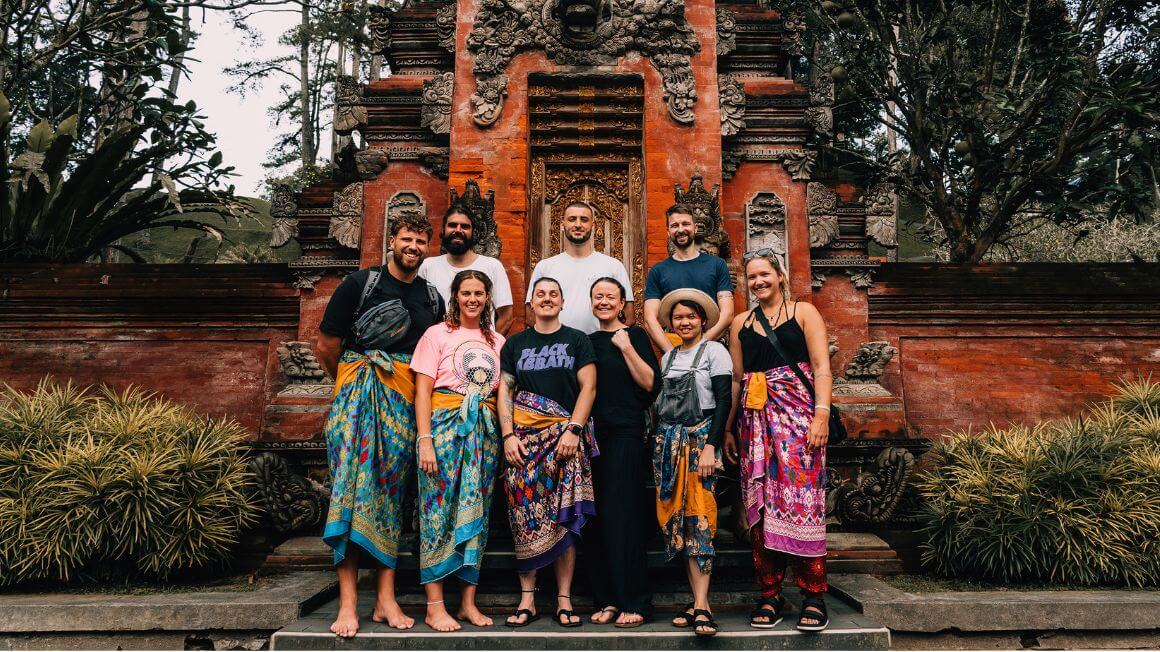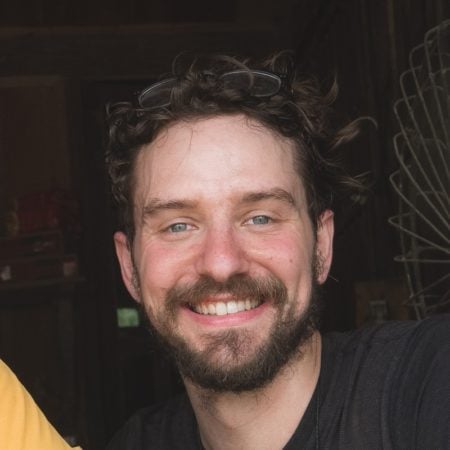There are a lot of yoga teaching trainings in Bali – so many that the mind reels just trying to sort through all of them on Google. Ubud, Canggu, Uluwatu, Kuta; all of these places have yoga, in one form or another. Choosing where to do your own spiritual studies in Bali can (honestly) be a daunting task.
But, as the “Yoga Sutra” highlights: yoga is the cessation of the fluctuations of the mind.
Clear your heads, my friends, and let my words wash over you. I’m here right now to tell you what my favorite yoga teaching course in Bali is!
Having just returned from the island to complete my own 200-hour YTT (Yoga Teacher Training), I can confidently say that Santosha is one of the best and most affordable yoga courses in Bali, for beginners and experts alike. It is comprehensive, accessible, and above all else very enlightening.
That being said, there are a lot of competing yoga studios in Bali that offer their own unique experiences. I cannot deny that they’re good but I can show you how Santosha compares to them.
So join me if you like on this brief review of my own yoga journey. By the end, I hope that you’ll understand better why Santosha is one of the top yoga studios in Bali and I have a good feeling you will!
Who is Santosha Yoga in Bali?
Santosha Yoga Institute offers one of the most comprehensive yoga teacher trainings in Bali. Their holistic approach to the path of yoga combines the wisdom of traditional yoga with a contemporary understanding of the body. At Santosha, you won’t learn a specific “style” of yoga but draw instead from the healing traditions of the Sri T Krishnamacharya – the father of modern yoga.
Santosha Yoga Institute was founded 10 years ago by Sunny Richards, a retired surfer who one day decided to pursue the teachings of yoga. She wanted to create a sacred place right in front of the ocean so students can fully enjoy their spiritual journey in and out of the yoga studio.
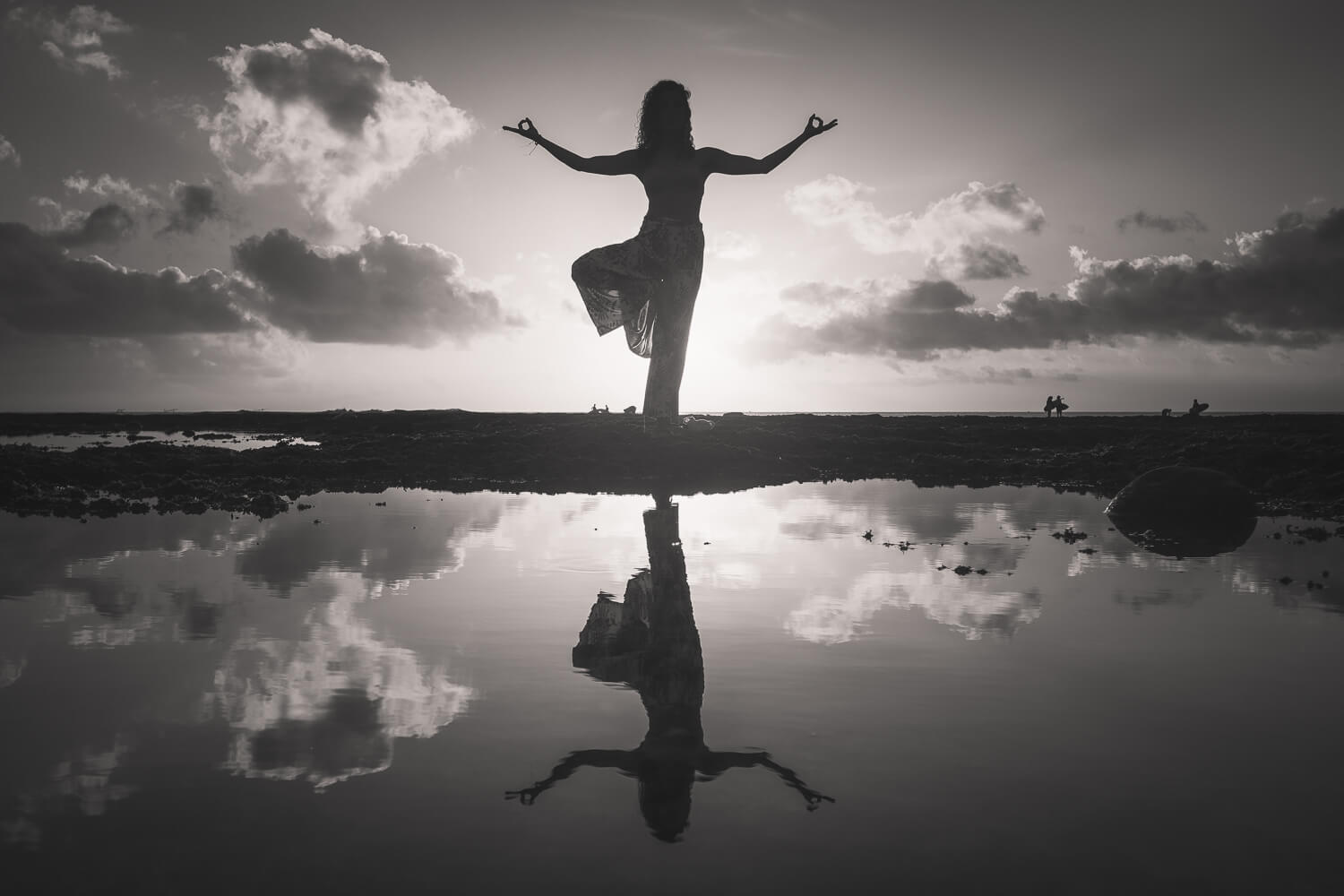
Photo: Roaming Ralph
The Broke Backpacker is supported by you. Clicking through our links may earn us a small affiliate commission, and that's what allows us to keep producing free content 🙂 Learn more.
Santosha Yoga Institute is based on the paradise island destination Nusa Lembongan – only 30 minutes boat ride from Bali. This island, uncrowded and sparsely populated, offers a real tropical island vibe. Life there moves at a slow pace and you can feel completely at peace. The island offers many activities – surfing, diving, snorkeling, free diving, and amazing beaches to swim and enjoy outstanding sunsets.
There are plenty of fancy hotels and budget hostels around Nusa Lembongan, and prospective yoga students can easily find accommodation to suit their own unique budget and travel needs. Even better – Santosha has a staff member on the island to help you with this process if you need some extra help. At the end of the day, Lembongan is as convenient as it is beautiful.
What kind of Yoga Retreats does Santosha Offer?
Santosha Yoga Institute offers 200-hour Yoga Teacher Training in Nusa Lembongan to any students, regardless of their yoga level. They must simply be open and commit to embark on a personal journey of self-discovery for a month.
This training provides an incredible opportunity not just for expert yogis or aspiring yoga teachers, but also to students who only want to deepen their practice (although, ironically enough, they’re usually the ones that end up teaching!). Ultimately, this yoga training helps you to come to know yourself on a deeper level and to acquire new tools to go through life with greater joy, passion, and ease.
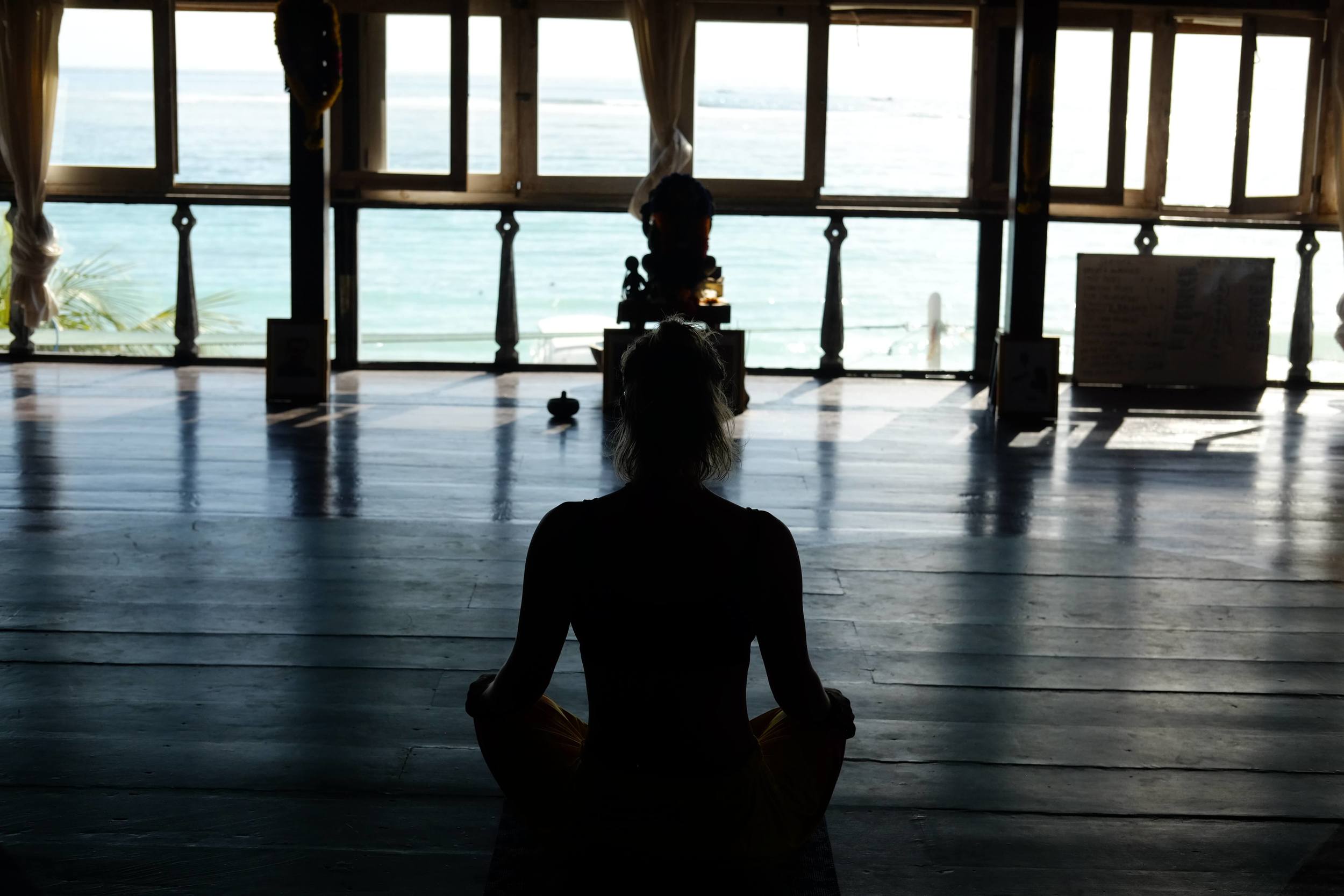
For those who wish to be a part of a yoga teacher training in Bali, Santosha will arm you with knowledge and confidence to lead classes and workshops. The only prerequisites to take part in the course are a sincere desire to get a deeper understanding of yourself and full dedication during the full 25 days of the training.
Santosah also offers yoga training in other regions besides Bali. There are courses and packages available in stunning Sri Lanka, India, and Brunei.
Sample Activities from Santosha’s Yoga Teacher Training in Bali
During this training you will be required to:
- Practice asana for two hours every morning at 5:45 am and right before sunset
- Practice pranayama and breath development
- Meditate daily
- Attend lectures and workshops about various topics, such as anatomy, postures, philosophy, yoga therapy, Kirtan, practice teaching, Yoga Nidra, and self-practice.
Why Study Yoga in Bali?
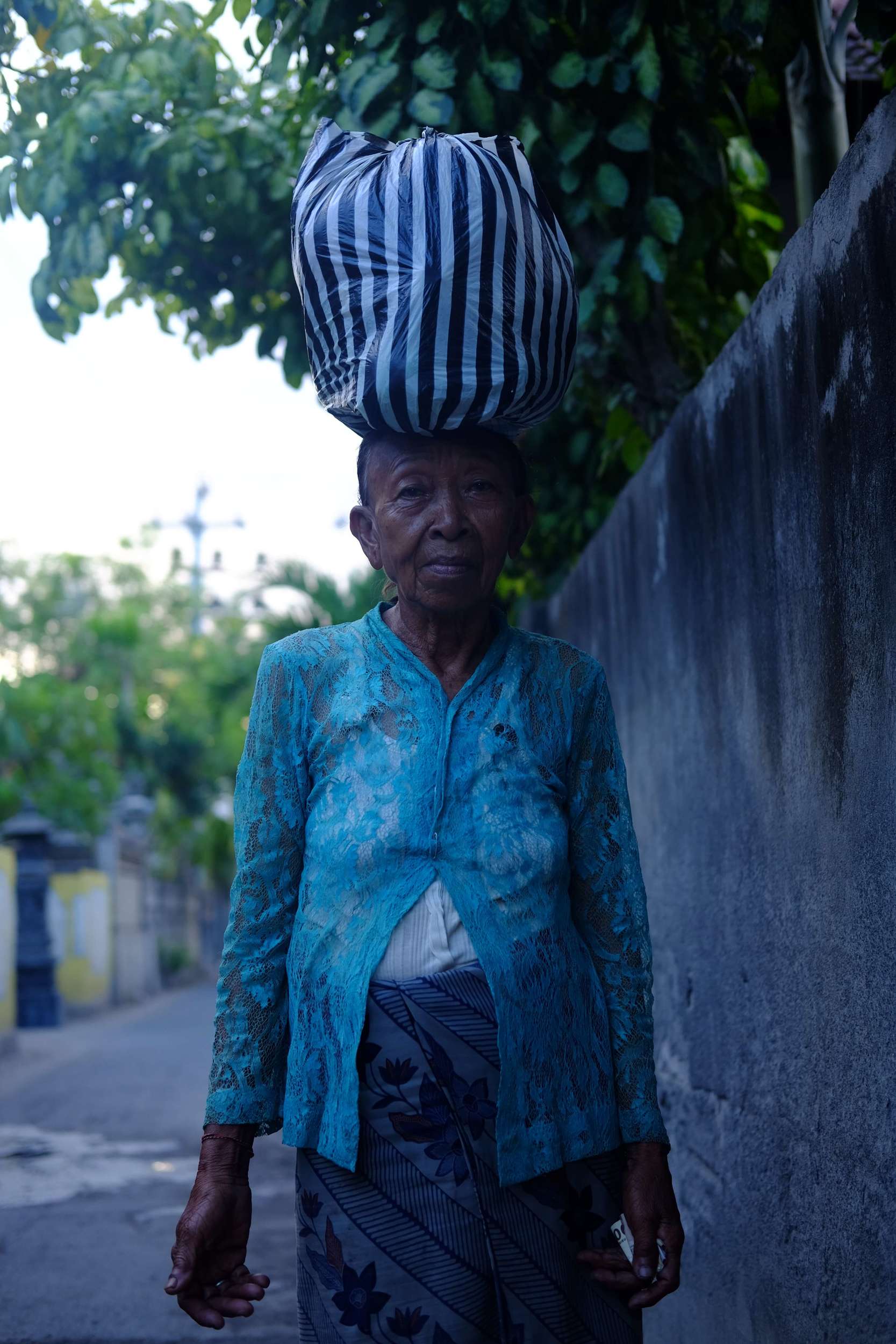
Bali is referred to as the Island of Gods for its unique spirituality. It is predominantly Hindu, while the rest of the country is mostly Muslim. Because yoga has some ties with Hinduism, the yoga culture organically grew in Bali – yoga retreats and schools have flourished on this Indonesian island.
If you study yoga in Bali, your spiritual journey will not be limited to the hours inside the shala – as soon as you step outside, a wave of spirituality will hit you. Hindu practices are extremely present in every moment of daily life. It is evident in the morning offerings, the ambient sounds of the gamelan, and the near-constant display of ceremonious gestures and events.
As a yogi, the biggest challenge is to preserve the peace of mind found in yoga practice whilst going through the daily routine. In Bali, it is incredibly easy. You just need to observe the locals to find your inner peace again. You’ll feel more relaxed, more mindful, and fully dedicated to your body, your mind, and your practice.
There are a lot of other things to travel in Bali for beyond spiritual retreats. You can explore tropical jungles, crystalline beaches, and hike in the mountains. The Balinese vibrant culture will leave an imprint on your heart forever and you will understand why people call this island paradise.
A Bit About Balinese Hinduism
In Balinese Hinduism, the traditional philosophy of life is called Tri Hita Karana – “the three causes of well-being.” The three causes are harmony among the people, harmony with nature, and harmony with God.
Following these principles, the Balinese people have gained a successful approach to life. They live in the present moment, share gratitude, and appreciate their surrounding environment (and there’s a lot to appreciate, trust me).
The Balinese live very close to nature because they consider it inseparable from divinity. They perceive spirits in all parts of the world and think that they reside everywhere. Crucially, they believe that the good spirits reside in the mountains and evils ones live in the sea.
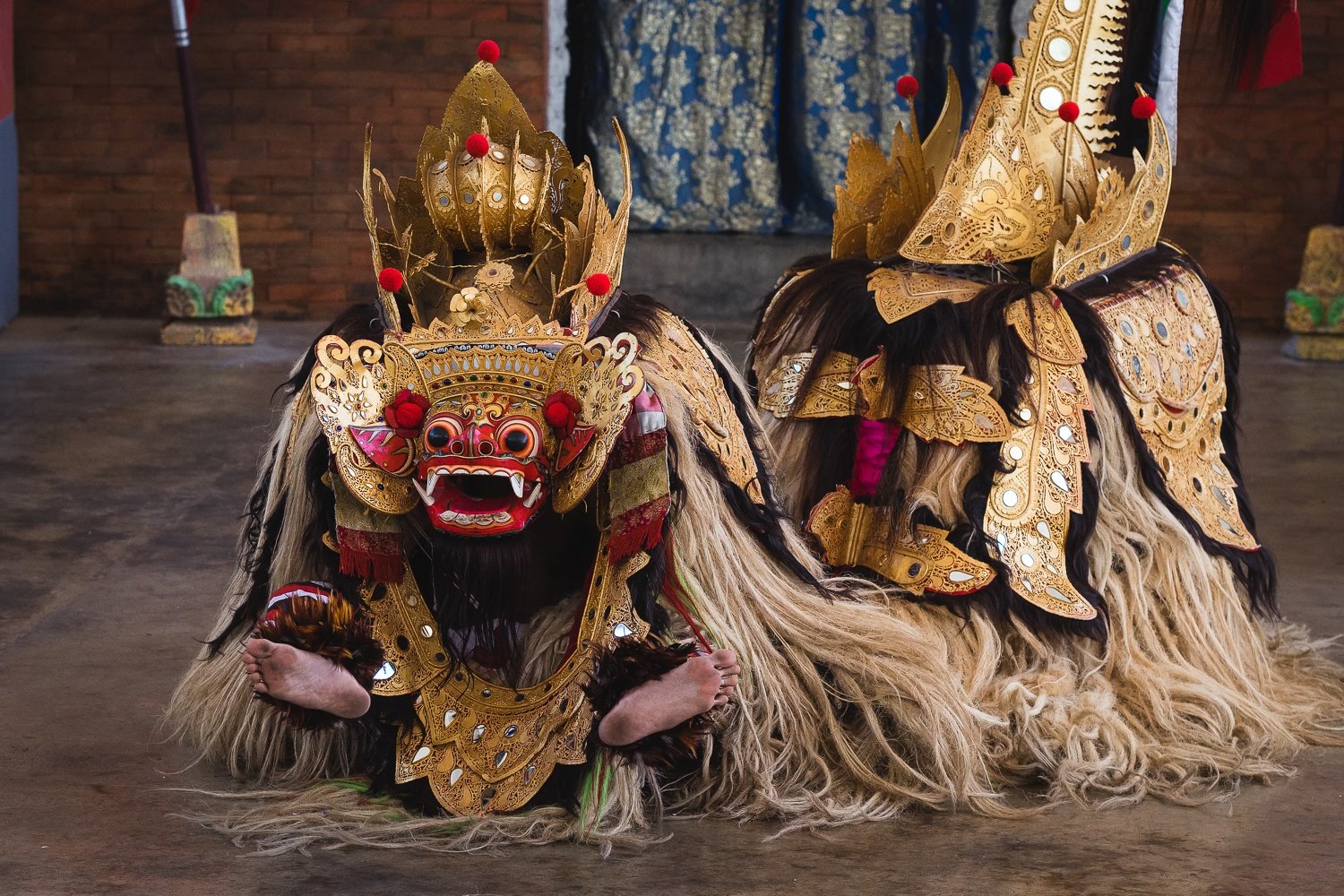
Photo: Roaming Ralph
Balinese people possess a beautiful sense of calmness and it’s very rare to find them freaking out or having an argument. The pace of life is beautifully slow here and you just instantly slow down.
They perceive the world as a collection of opposites: good and bad, right and left, young and old, male and female, sun and moon, sea and mountain. To them, this binary conflict constitutes the universe. The ultimate aim of their spirituality is to achieve a state where the two forces are in balance. This is the main purpose of ceremonies, prayers, and offerings.
Life in Bali is seen as a cycle. For example, Balinese people strongly believe in reincarnation, that everything has a soul and that each family member returns every five generations. A human being could be reborn as an insect or animal and this belief leads to respect for all things.
Why I Wanted To Join a Yoga Teacher Training in Bali
I’ve always been into yoga. Seeing all the slender, bendy, flexible people contorting themselves always has fascinated me. What really got to me was the beauty of the body in these movements – the balance and the strength that it takes to achieve these inversions was utterly impressive to me.
When I started to take yoga classes I struggled to find the right one for me. All the classes I found were very physical and I was constantly forcing myself to do strenuous practices even when my body wasn’t feeling like it. I started to get frustrated and angry at myself when I couldn’t keep up with the class or when a pose didn’t feel right.
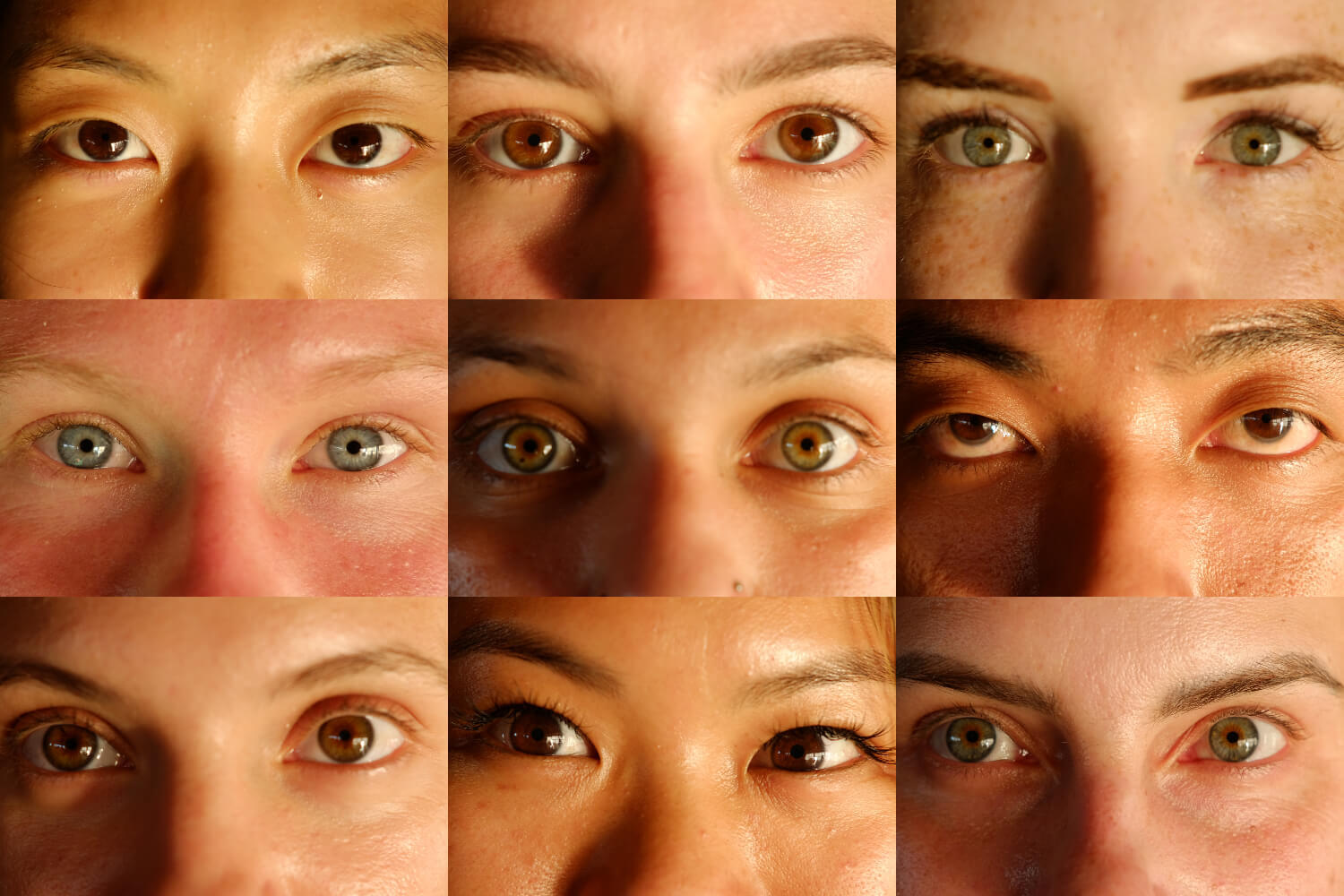
Photo: Silvia Pipponzi
But then a friend of mine opened my eyes and made me realize that I wasn’t supposed to struggle and to get frustrated when practicing yoga. The asana practice (the physical part) is just a small part of yoga and is simply a tool to get to know your body, your breath, and your mind better.
I stopped going to my yoga studio, bought a bunch of yoga books, started to read about the philosophy and the goals of asana practice and to practice by myself, in my living room. My curiosity grew and I got to a point where I needed to find a way to extend my practice on a deeper level. I wanted to get away from my routine by finding a place where I could fully immerse myself into yoga.
That’s how I found the Santosha Yoga Institute.
Why I Chose Santosha to do my Yoga Teacher Training in Bali
Santosha’s curriculum is different from other yoga teacher training in Bali I’ve seen. They focus much more on the inner and deeper meanings of yoga, as opposed to the physicality of it. The focus is on topics like philosophy, self-reflection, meditation, and so on. It’s not just an asana training, but a holistic yoga training.
Santosha teaches you how to meditate, to breathe, and how your body works in relation to your mind. They do not reject the physical side and will still cover asanas according to your own body capacity.
Santosha teaches you how to apply yoga principles in your daily life, not only on your yoga mat. They change your way of thinking. The teachers show you ways of approaching life’s difficulties with more positivity and lightness. They teach you to fully live in the present moment and to appreciate every minute of it.
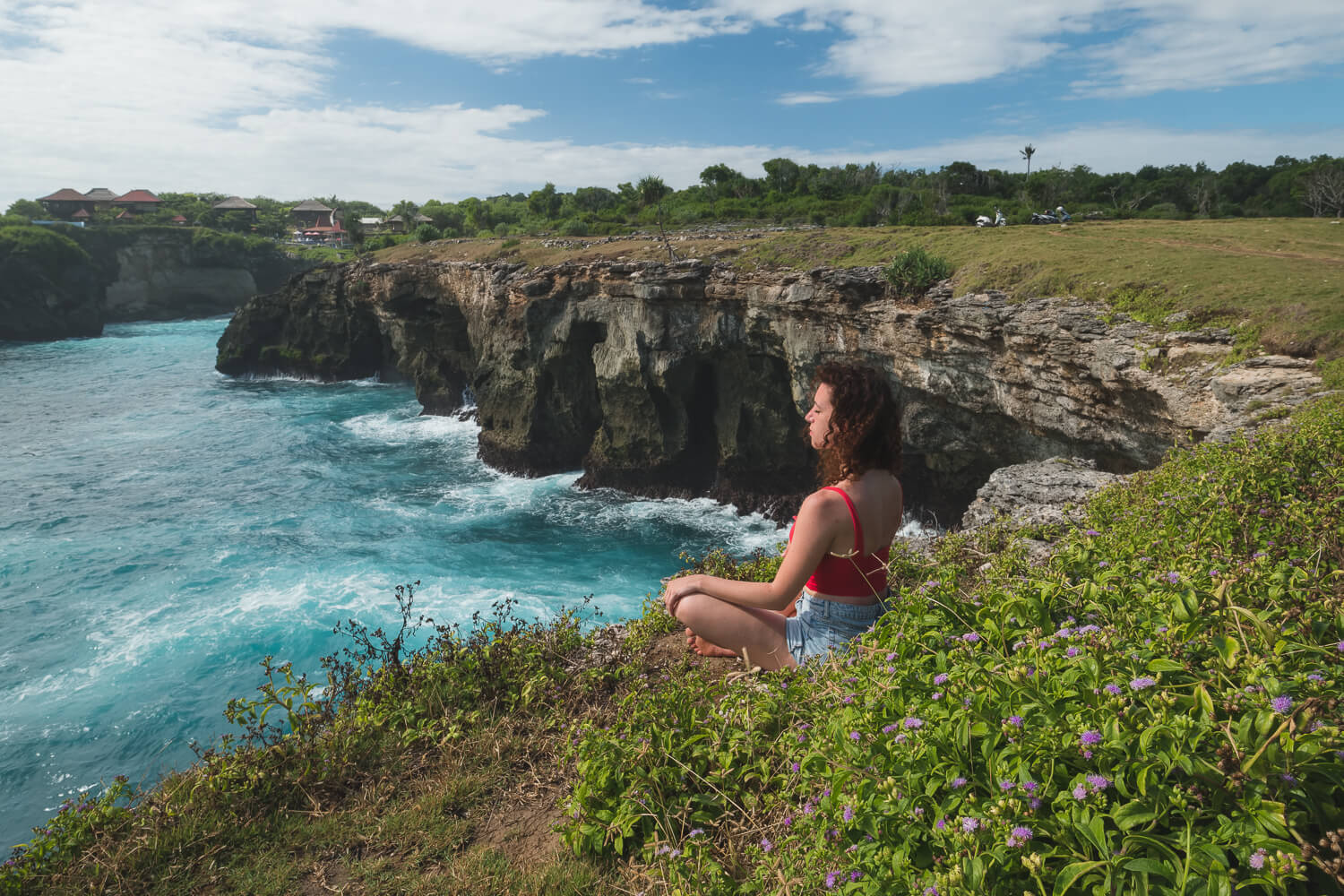
Photo: Roaming Ralph
Santosha also covers practices like mantra, Kirtan, and pranayama, though regular classes usually touch only lightly on these topics.
Last but not least, you will spend a lot of time learning about the history and philosophy of yoga at Santosha. This not only deepen your practice, but it also encourages personal growth and pushes you to get to know yourself better.
The subtle body, the yamas and niyamas, and the theories of Ayurveda are very important topics during the philosophy classes. To many yogis, these concepts are just familiar words that might come up in class every once in a while. But for new students taking a YTT with Santosha, it is an opportunity to really study them on a deeper level.
What Real Yoga Training in Bali Looks Like
One thing that is very important to be aware of is that this yoga teacher training in Bali is not supposed to be for wannabe practitioners.
The focus of a proper YTT program should be more on gaining yoga insight than on becoming some hot-shot instructor. Of course, the training prepares aspiring yoga teachers to lead their own classes but it’s also one of the best ways to deepen your own practice.
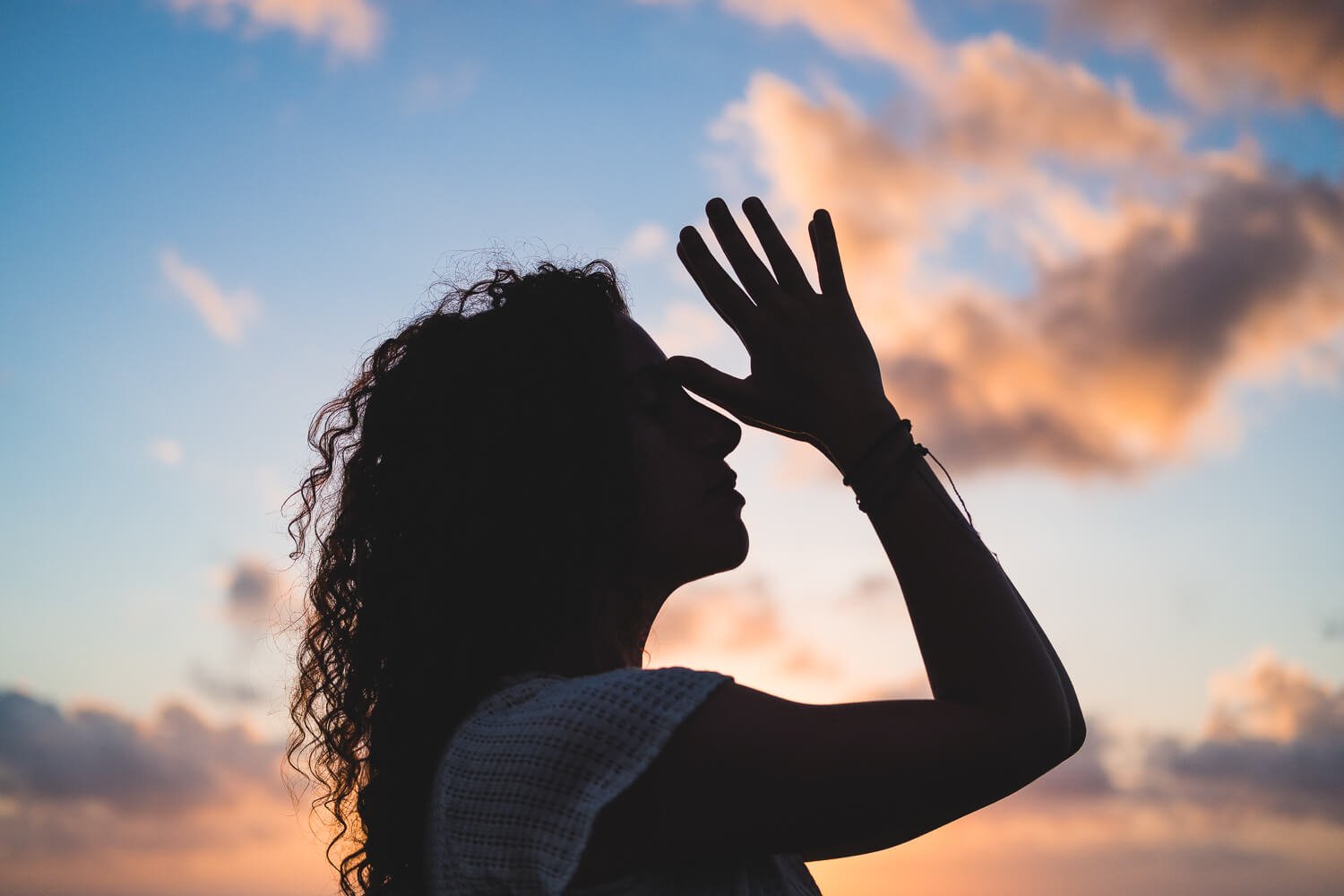
Photo: Roaming Ralph
Regardless of your teaching aspirations, Santosha YTT is an experience that will push you to dig deep and will challenge you mentally, physically and spiritually. Like everything in life, the only way to improve is to put time and effort into it.
When you sign up for this YTT, you’re committing to attending all the lectures and sessions, so you inevitably will become much more consistent and disciplined. The opportunity to spend a full month completely focused on yoga whilst on a tiny, quiet island where there is not much to do besides surfing, diving, and playing in the ocean, is an added bonus.
A Brief Review of Yoga Concepts
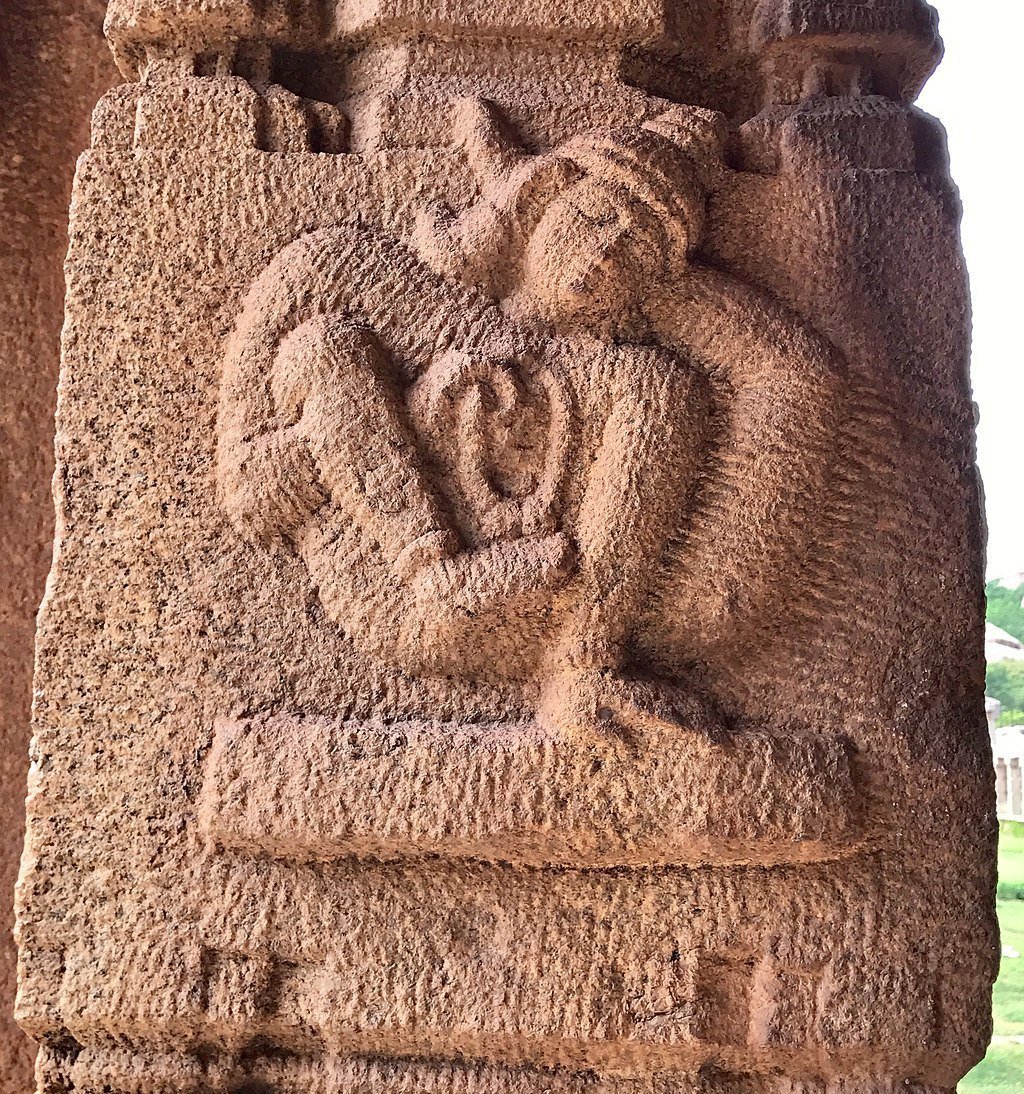
Photo: Ms Sarah Welch (WikiCommons)
The main concept behind yoga is: when the activity of thinking is not there, there you are. Thoughts are just like clouds covering the sky. Once they have disappeared then your True Self, which has always been there, just like the sky, is uncovered.
Yoga is for everyone and always has been. Since ancient times, Yoga has been continuously adapted to suit the needs of various individuals from different times, cultures and traditions. Unfortunately, the Yoga tradition has too often been turned into a mixture of fact and fantasy, filled with misunderstanding and misinterpretation, especially in the modern world.
According to Patanjali’s pivotal Yoga Sutra (written 400 B.C.), yoga helps “to cease the fluctuations of the mind”. He goes on to explain the inner reasonings of yoga, Asanas, and the “8 limbs of yoga.”
Each limb prepares the body and the mind for the higher stage. The first 4 limbs are “external”, related to interactions with the world. The last 4 are “internal”, related to the mind.
The first limb includes the Yamas (the DONTs’), aka ethical behavior. The Yamas are:
- Ahimsa – non-violence, no killing, not eating meat, replacing destructive actions with positive ones.
- Satya – truthfulness, speaking with intention, telling the truth as best as you can to others and most importantly, to yourself.
- Asteya – not stealing either physically, emotionally, or mentally, preserving trust in others and yourself.
- Brahmacharya – abstinence, celibacy, living the pure life and directing your energy in things that matter only.
- Aparigraha – non-attachment to either material belongings, or thoughts.
Once a yogi learns to restrain his/her impulses, the next step is to concentrate on positive actions called Niyamas (the DOes), like cleanliness, contentment, austerity, self-study, and devotion to God.
The third limb is Asana practice. The asana has been defined as the achievement and maintenance of precise physical forms or poses. The goal of the asana practice is not to be “fixed” or “rigid,” – an overabundance of either will cause physical problems. Poses must be fluid and a reflection of one’s internal spirit, guided by the breath. This will lead to deeper self-awareness, and self-awareness is the key to any process of self-transformation.
My Initial Impressions of Santosha
On day 1, we met all together in our beautiful shala (yoga studio) on the beach. We walked in, sat down in a big circle, and introduced ourselves to each other. We were twenty people from all over the world: Australia, New Zealand, Italy, Switzerland, Norway, Korea, the Philippines, Germany, France, the US, Alaska, Canada, Mexico, and Brazil.*
Everyone had different reasons and different expectations for joining this yoga training. Some may have been:
- Traveling around the world for months at a time and wanted a break
- Willing to reconnect with themselves
- Wanting something new to break their routines
- Wanting to become a yoga teacher to change their careers
- Being present for a myriad more reasons
Regardless of their backgrounds, everyone appeared to have beautiful energy and curiosity.
From the second day on, we started our day very early in the morning when it was still dark (5:45 am) with a yoga class. We first practiced breath awareness, followed by a mellow asana sequence, before finishing up with a lovely meditation session. After the morning practice, we enjoyed an hour break and had breakfast together.
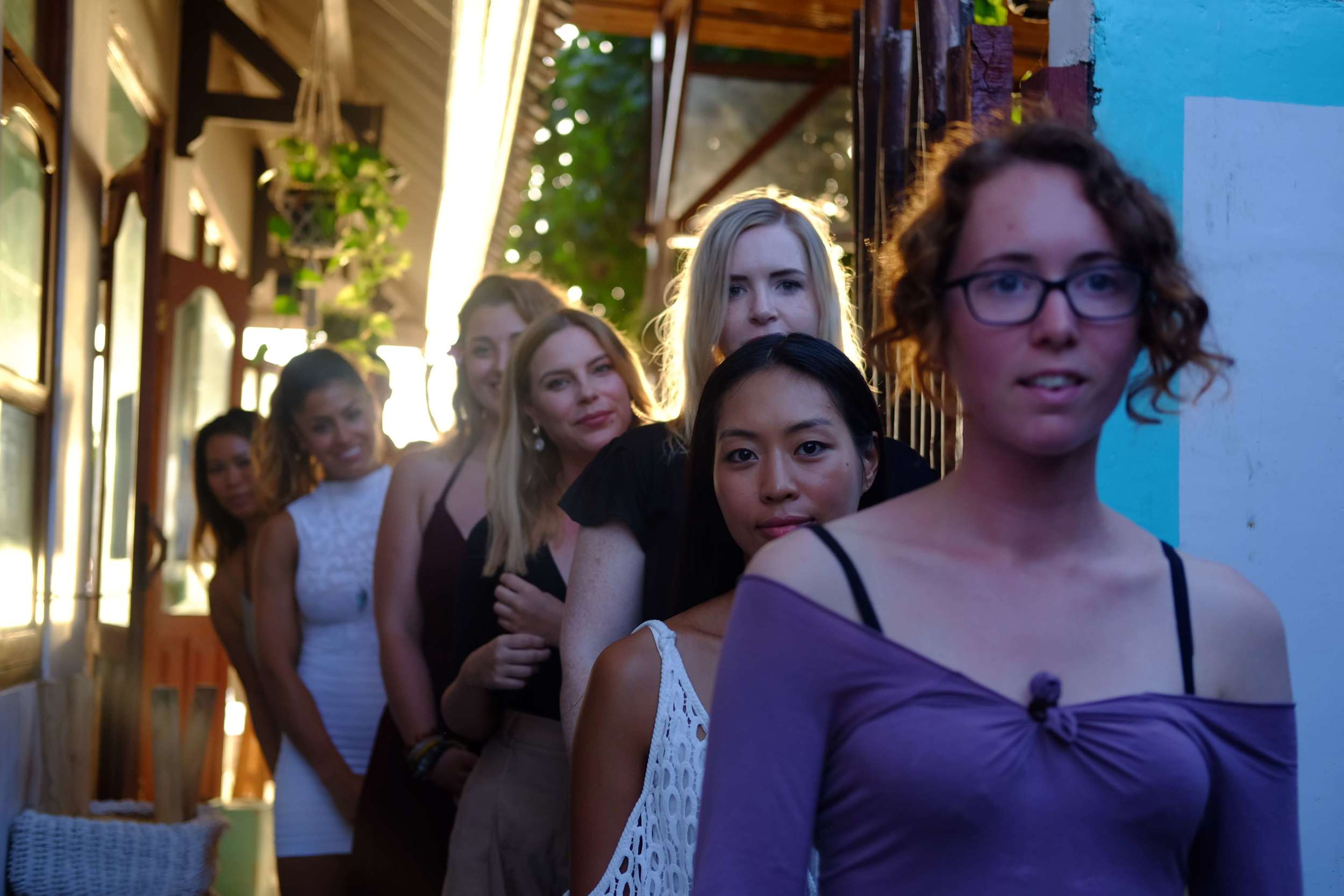
Photo: Silvia Pipponzi
It was initially quite hard to wake up that early, but our bodies rapidly accustomed to getting up at the same time each day after a few days. Eventually, we actually started feeling more energized and alert.
Practicing yoga every morning also warms up the digestive system and helps nutrients move more easily through the body, whilst the breathing techniques stimulate the entire body and mind. It’s actually way more effective than caffeine! (And that’s coming from a native Italian and former espresso addict.)
*Most studios teach to groups of 10 – 20 students. Being a part of any sort of private yoga in Bali is more expensive.
Week 1 – Yoga and Anatomy Lessons
In the first week, we had anatomy lectures. Our wonderful teacher, who was also a physiotherapist, offered us an incredible 4-day full immersion into the human body.
An understanding of anatomy is a crucial piece of the puzzle that is Hatha Yoga. Physical forms of yoga involve moving and stretching the body, as well as increasing blood flow within the body.
Many yoga students will like the way they feel after a good session of practice. They often feel lighter and invigorated without knowing why, but a yoga instructor must know what is causing these feelings within the body and the mind. So as future yoga teachers, we need to study anatomy to understand the body, the safe and proper alignment in yoga poses, to learn the principle of individual differences, and to keep everyone safe during the class.
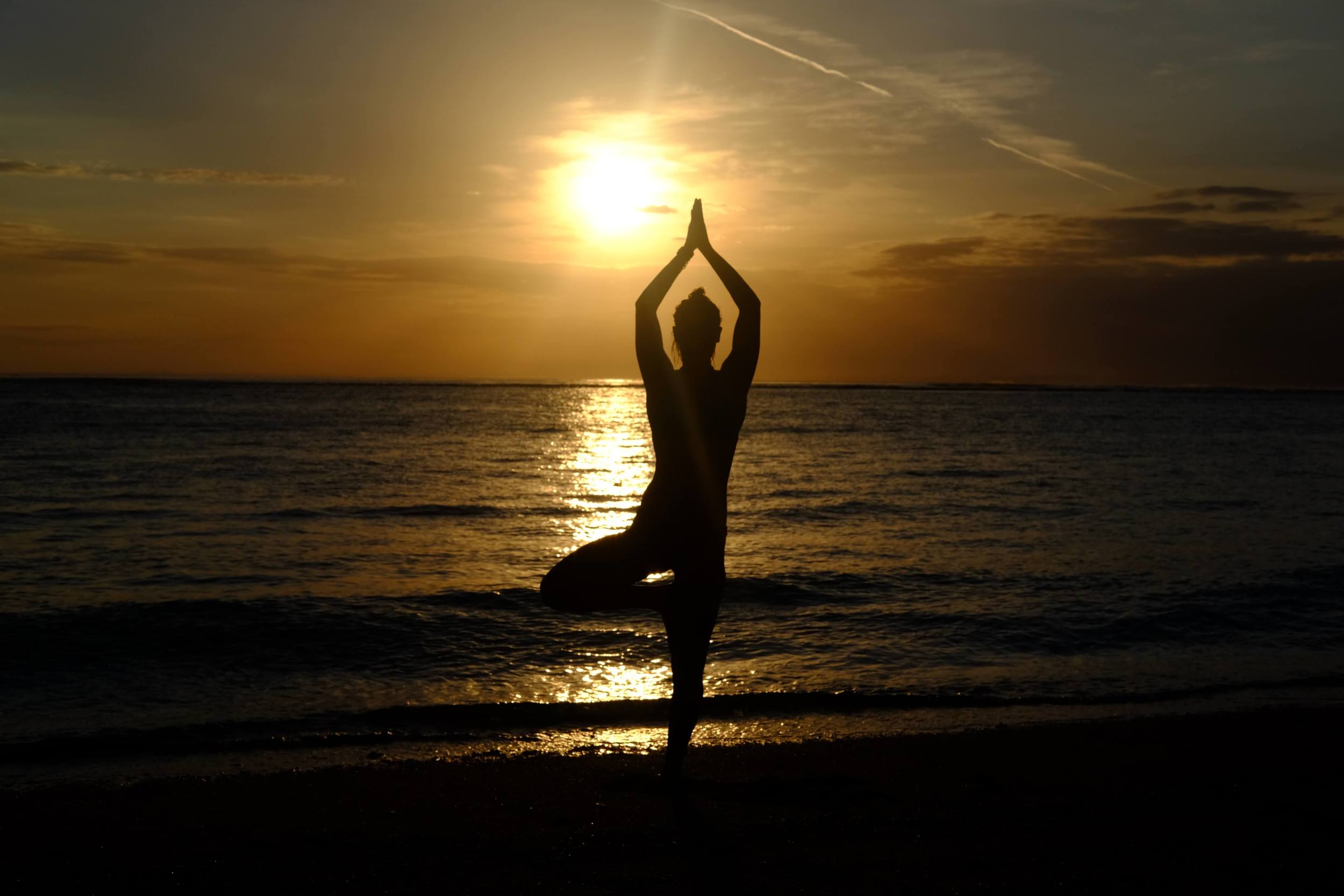
Photo: Silvia Pipponzi
The anatomy that Santosha Yoga Institute offers goes beyond learning the names of muscles and bones. The anatomical lessons emphasize concepts that are relevant to yoga, like how the body moves and how bodily structures relate to the alignment of poses. Understanding the basic anatomy is important to better understand the purposes and benefits of different poses and how to practice them in a safe manner.
During the anatomy class, we had the opportunity to break down each individual pose, understand the relationships between different poses which helped us attaining more advanced ones. We also received direct feedback from our teachers, which was much more constructive than just reading about principles. On my second day of anatomy, I realized that I’ve been practicing Downward-Facing Dog the wrong way for years!
Week 2 – Yoga and Philosophy
During the second week, we attended philosophy lectures. These were definitely the most inspiring and life-changing portion of all teachings, for me at least.
Yoga philosophy is a tool that allows you to exist in the present moment and be the master of your mind. It shows you how to tap into your inner being, reach more deeply not only into our practice but also as human beings, thereby, broadening our understanding of the essence of yoga.
I learned that it is not the amount of action but the depth of experience that makes life rich and fulfilling. Yoga philosophy subsides mental activity in order to reach the ultimate source. Asana practice, on the other hand, is the physical practice that demands the steadiness and comfort of the body. Both subjects must be in a perfect combination in order to reap the desired benefits.
Yogic philosophies are just like maps that guide both the teachers and practitioners as to whether they are moving on the right path during their yoga practice. During our classes, our teacher was making us question everything and through group discussions, we were trying to find answers. I found that for certain people, it’s been very hard to find courage throughout their lives to let go, trust, and open their minds.
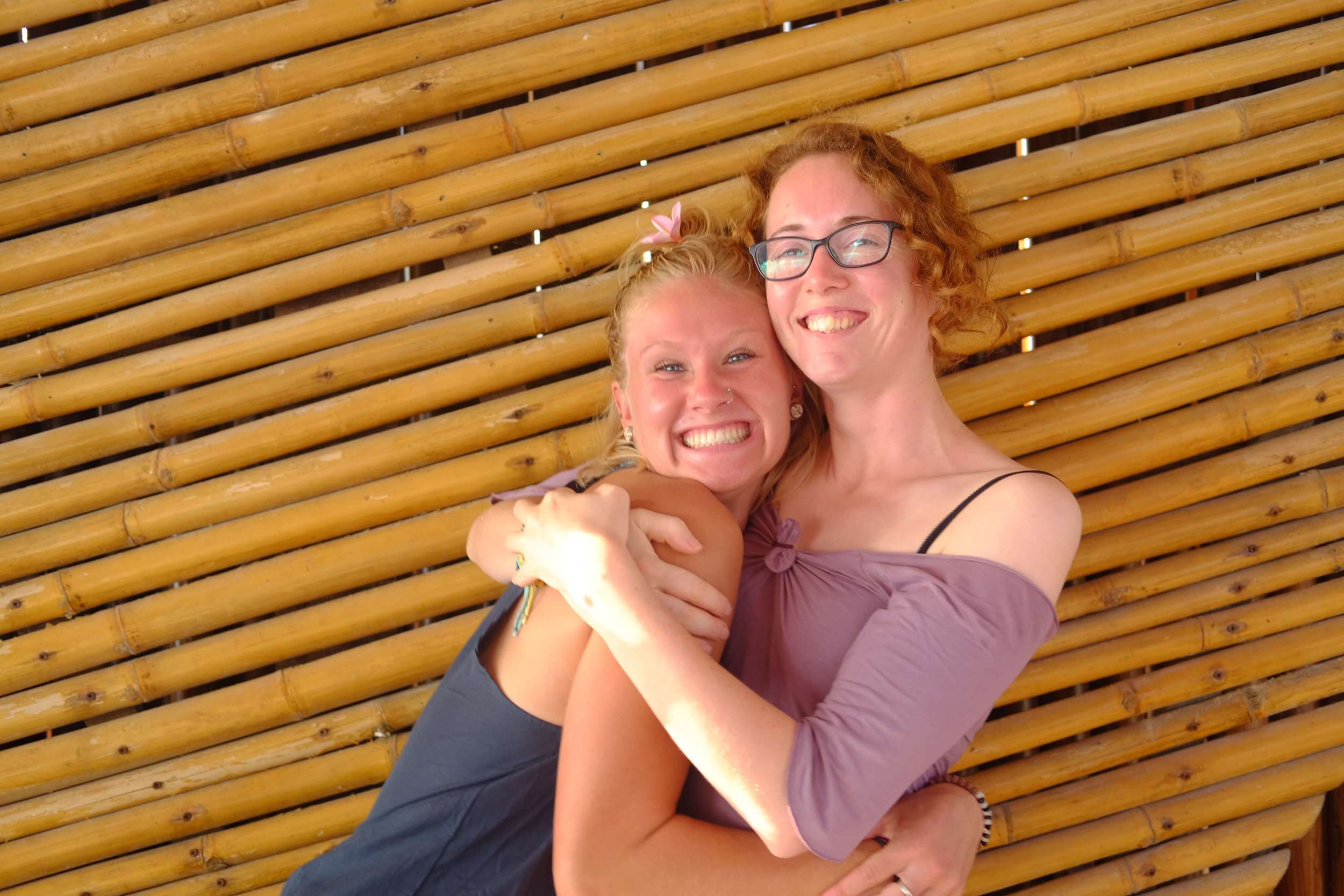
Photo: Silvia Pipponzi
How can we be able to observe the fluctuations of the mind if we are not open and honest with ourselves and our feelings?
One girl came from a very insular German family. She was raised to believe that suppressing her feelings and always showing herself strong and without any weaknesses was the right thing to do. In the second philosophy class, she had a break down in the middle of the meditation. She said that she wasn’t used to talking about such sensitive topics, and when she finally did, she freed herself from her blockages.
Philosophy is regarded as the root of yoga. If you have to measure the strength of a tree, you must check the depth of its roots and not its height. Hence, trees with deep roots are not ripped from the ground easily by a storm or even say a tornado.
This is the universal law of nature and the same applies to yoga. If the base or the root, i.e. philosophy of yoga, is clear and deep in the mind of a teacher, they can lead their classes and guide their students confidently.
The Final Weeks at Santosha’s Yoga Teacher Training in Bali
During the 3rd and 4th weeks, we started to put everything together. We created sequences and learned more about how to teach. We also delved deeper into the teaching methods and the foundation of sequencing and began to understand poses and how to break them down/teach them.
It was very hard at the beginning to feel comfortable with the idea of speaking in front of students – to describe every posture, breath, and transitions. The thought of choosing the right words (or cues, as we call it), using the right tone of voice, and respecting individual differences/limitations was very intimidating.
In the 3rd week, everyone achieved a good understanding of the postures and principles, but there were some people who still felt nervous about teaching. It takes a huge amount of practice and self-confidence to be in front of a group of people and lead them.
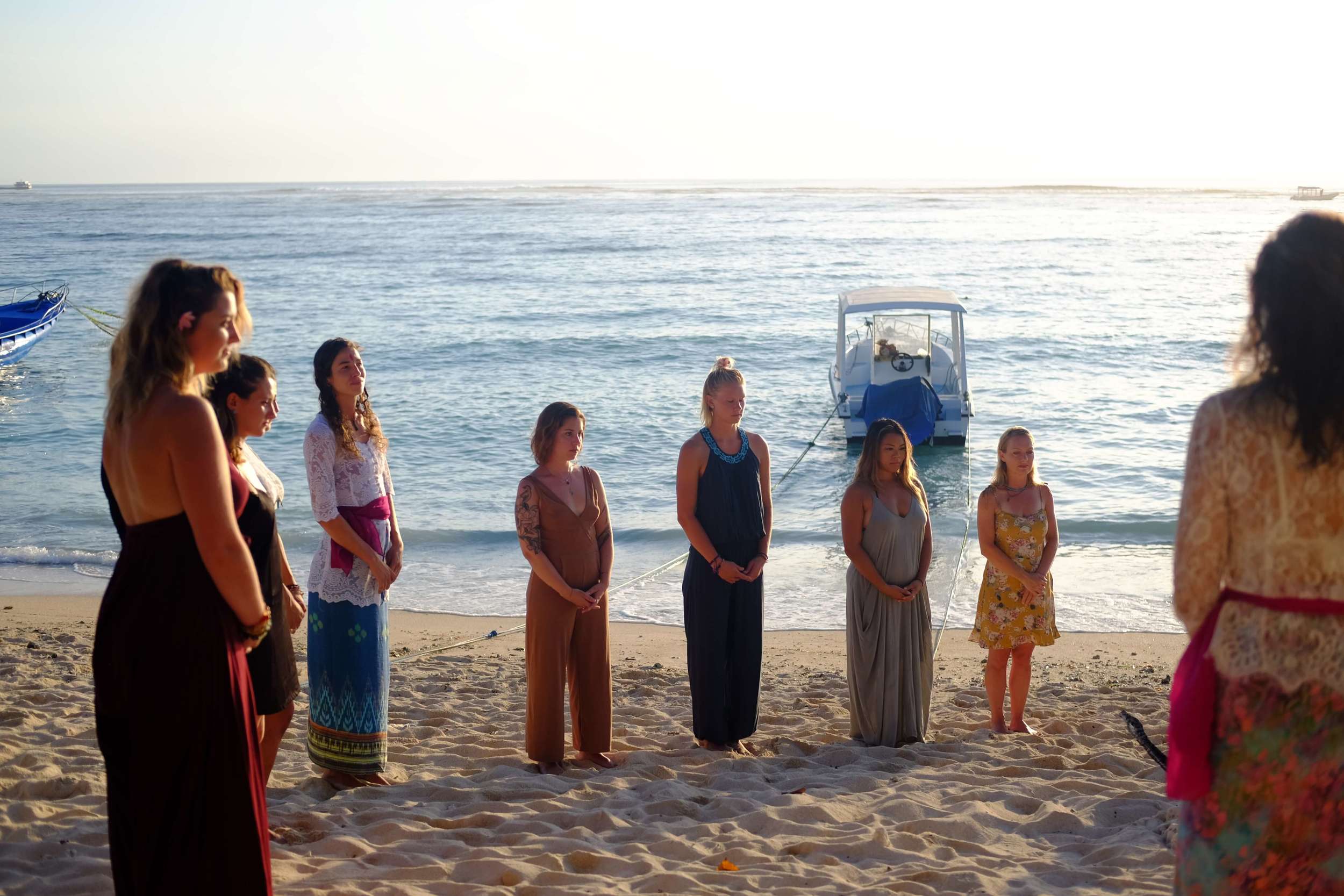
Photo: Silvia Pipponzi
We, however, spent a lot of time practicing and teaching short lessons to one another and eventually became more confident with ourselves the more we did. There were lots of opportunities during class but we were practicing also during our time off – at the beach, during lunch, and while we were doing other activities.
One morning, I went surfing. Some surfers were complaining because of soreness they had from the day before. I offered to lead a 15 minutes yoga class on the sand to stretch and relax the body before going to surf. Everybody was so happy! And even though it was quite challenging, it was an incredible opportunity to improve my teaching skills and self-confidence.
The Choices – More Yoga on Nusa Lembongan and Bali
There are plenty of yoga teacher trainings on Nusa Lembongan and lots of studios that offer YTT. I don’t like to say that there are better studios than others because everyone is so different and looking for something different. To find a yoga studio that suits you best, you just need to figure out what you really want.
Some studios focus more on the physical part of yoga and just briefly touch the philosophy. Some others practice Ashtanga Yoga, which may or may not be the right style for you.
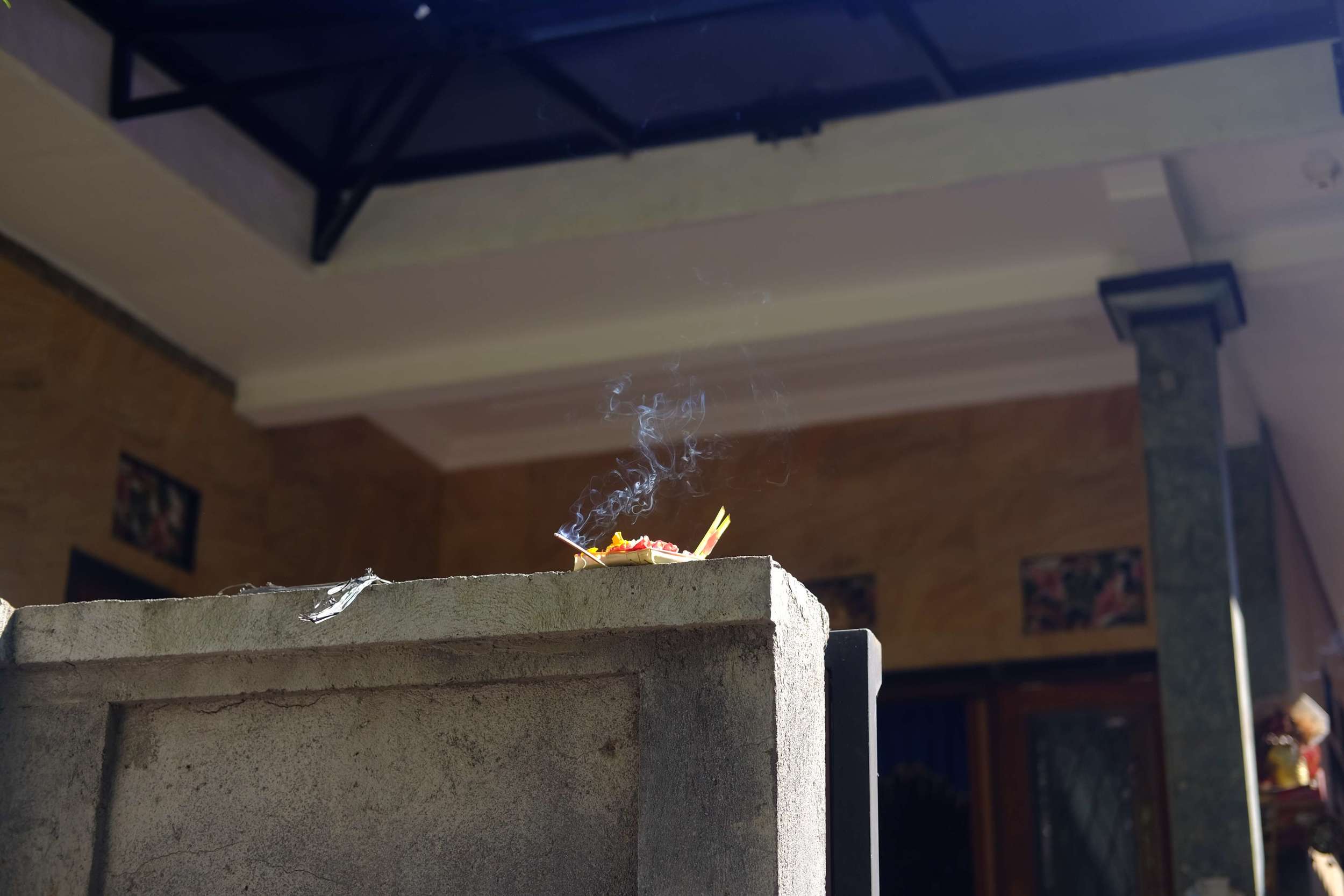
Photo: Silvia Pipponzi
I personally find ashtanga too hard for my body and not aligned with the Yoga Philosophy I’ve learned. Ashtanga yoga has a reputation for being the more athletic style of yoga. The teachers are allowed to use their hands-on adjustments and it can be too intimidating for some people, or too rough on their bodies.
To give you an idea of what is on offer, below are some other yoga studios on Nusa Lembongan and Bali:*
*There are a lot of awesome yoga studios in Bali; way more than I can mention.
1. Yoga Bliss
Yoga Bliss is also a yoga studio on Nusa Lembongan. While Santosha is located right in front of the beach, Yoga Bliss is 10 minutes away from the ocean. The training at Yoga Bliss starts later in the morning than Santosha but, trust me, you’ll want to be practicing your sun salutations while the sun is rising. Starting later also means you may miss drinking a beer on the beach during sunset.
Yoga Bliss training is suitable for students with a minimum of 1 year dedicated asana practice. Their classes are pretty hard and physically demanding. Santosha’s yoga training is suitable for everyone on every level since the asana training starts on a mellow level and builds up to get more advanced as the course progresses. There are always variations for those who are not ready to perform more complicated poses as well.
2. Yoga Dunia
Yoga Dunia also is located on Nusa Lembongan. Like Santosha, this studio offers 200-hour yoga teacher training courses and is located in front of the beach. It offers asana training, anatomy, philosophy, meditation studies, and, as an added bonus, snorkeling excursions. Here, the day starts later at 7:30 am and ends at 7:30 pm.
The main difference between Dunia and Santosha is that they offer you a package deal of accommodation, snorkeling, massages, and the choice to attend a yoga class. For these reasons, I get the feeling that the yoga there is more like an afterthought or an optional activity, as opposed to a dedicated yoga teaching course.
3. Zuna Yoga
Zuna Yoga is a larger yoga retreat in Bali that offers YYT in Ubud, Gili Meno, and Canggu. This retreat provides a strong foundation in the physical aspects of yoga, including asana, alignment, anatomy, adjustments, modifications, and safe biomechanics. The training includes a vigorous two-hour asana practice most days, twice daily.
Since the asana classes are advanced, they strongly recommend that applicants have one year of consistent asana practice and are comfortable with backbends and inversions. So if you’re new to yoga this wouldn’t be an appropriate program.
The Essence of Santosha’s Teachings
The Santosha viewpoint is very much influenced by the teachings of T.K.V. Desikachar and his student Gary Kraftsow, who in turn became Sunny Richards‘ teacher (Santosha’s founder). T.K.V Desikachar was Krishnamacharya’s son and refined his own yoga style called Viniyoga.
A Viniyoga class is slower than Ashtanga, though it uses coordinated breath with movement. Like Iyengar Yoga, it is known for his therapeutic applications, although Viniyoga concentrates less on alignment and more in varying the length and tempo of breathing. His pupil Gary Kraftsow founded the American Viniyoga Institute.
Desikachar’s teachings are about individual differences and these are very important principles that Santosha wants to transmit to future yoga teachers. During the teaching classes, we were asked to design classes for certain demographics, such as mothers, athletes, children and to specify what kind of health issues they had and how to address them. For example, wrists problems, scoliosis, hip surgery, insomnia, stress, panic attacks, etc.
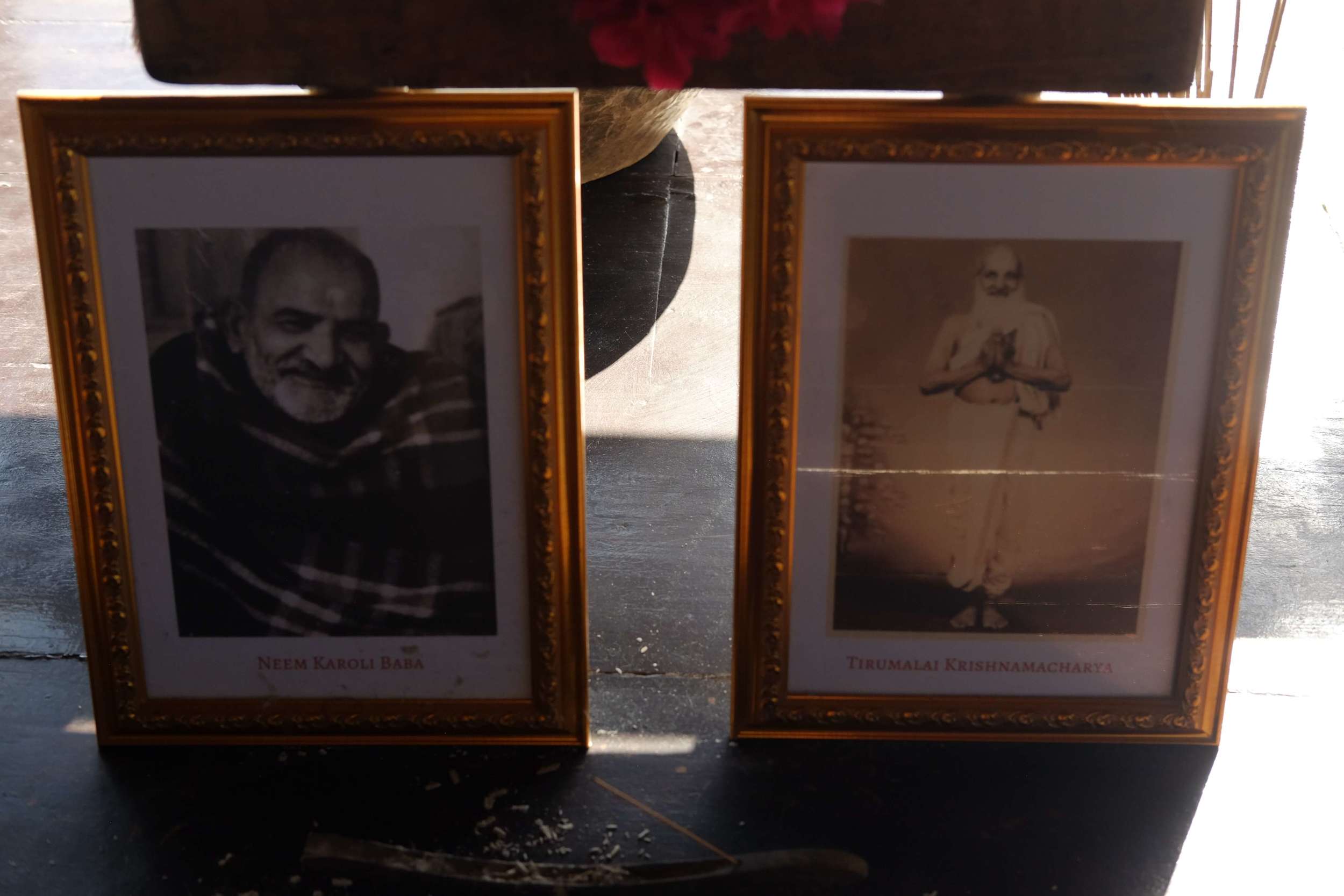
Photo: Silvia Pipponzi
Once we chose our specific demographic we had to design a 4 weeks yoga course for this specific group of people.
These assessments were incredibly useful to understand that we always need to get to know our students as much as possible. Only then can we offer variations for each asana and provide special treatment.
On a more serious note, you never know what kind of person is coming to your yoga class, so the first rule is to keep everyone safe! For example, I will never ask a woman with cervical problems to perform headstand or sun salutations in her first class. Yoga is supposed to help people feel better, but it takes time, patience, trust and respect for our bodies to get there.
Final Thoughts on My Yoga Teacher Training in Bali
I started this course with Santosha to deepen my practice and to work on myself. But the way it has transformed me has exceeded my expectations.
This journey has been a beautiful gift. I opened myself to the spiritual world, learned the art of meditation through which I started to observe myself, became aware of the power of little moments in my life, and was able to embrace my good and bad feelings.
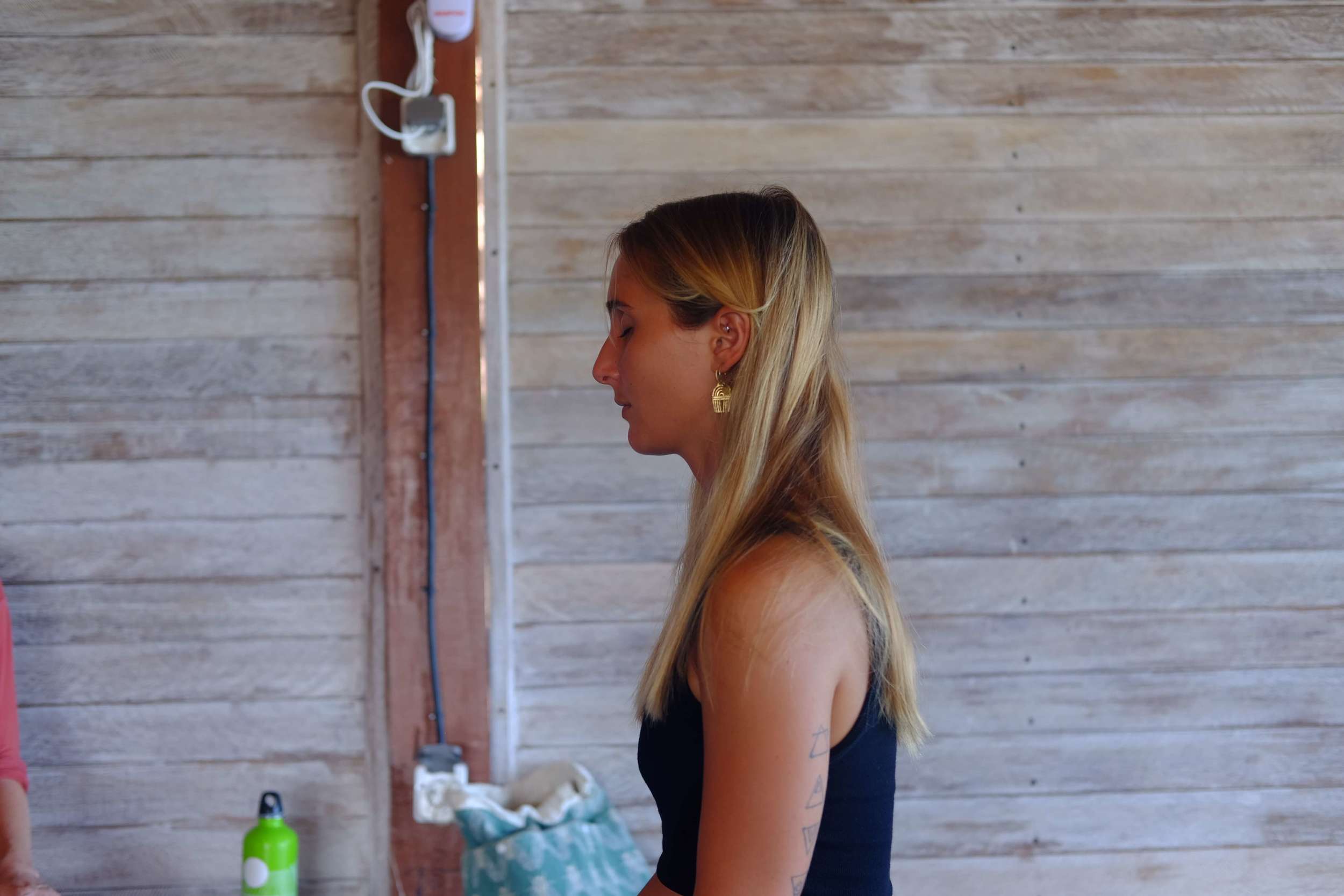
Photo: Silvia Pipponzi
Santosha taught me to appreciate my body and to take care of it during Asana practice. I met beautiful people who became my family, my best friends, and my yoga tribe.
Santosha is the right choice because:
- The location is beautiful, as not all the YTT are located right in front of the ocean.
- The teachers are humble and are always ready to help you out, in and out the Shala, day and night. All the teachers constantly observe you not only to check your posture but to make sure you feel emotionally comfortable. They are not psychologists, but through yoga, they master tools to deal with their issues and they want to make sure you’re getting the best from this experience.
- This is a great yoga training in Bali for beginners! You don’t need to be able to perform complicated Asana to be a good teacher (or to be skinny and young). All you need to benefit from this course is knowledge of the principles and a deep desire to share them with those who need it.
In conclusion, the Yoga Teacher Training with Santosha will guide you through a wonderful personal journey that you will cherish forever and that will help you become the better version of yourself. So what are you waiting for?
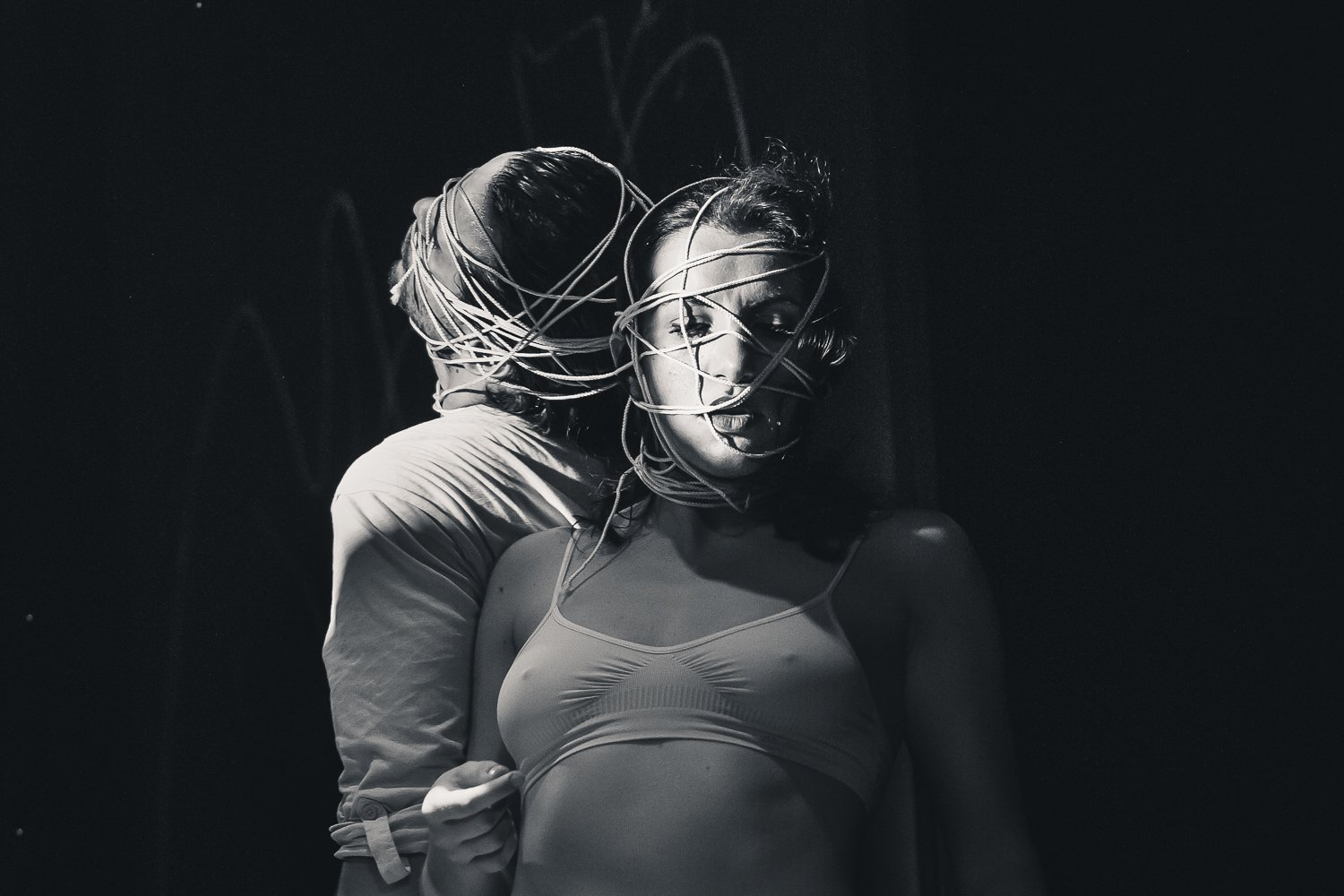
About the Author: Silvia Pipponzi
Silvia Pipponzi is a professional dancer that first approached yoga because of the need to treat physical injuries. After taking several classes (and loving them), she eventually pursued becoming a yoga teacher herself and was recently certified. Her current classes are full of movement, deep breathing and smiles, and her mission is to try to make everyone expand to the best of their possibilities.
Buy Us a Coffee!
A couple of you lovely readers suggested we set up a tip jar for direct support as an alternative to booking through our links. So we created one!
You can now buy The Broke Backpacker a coffee. If you like and use our content to plan your trips, it’s a much appreciated way to show appreciation 🙂


